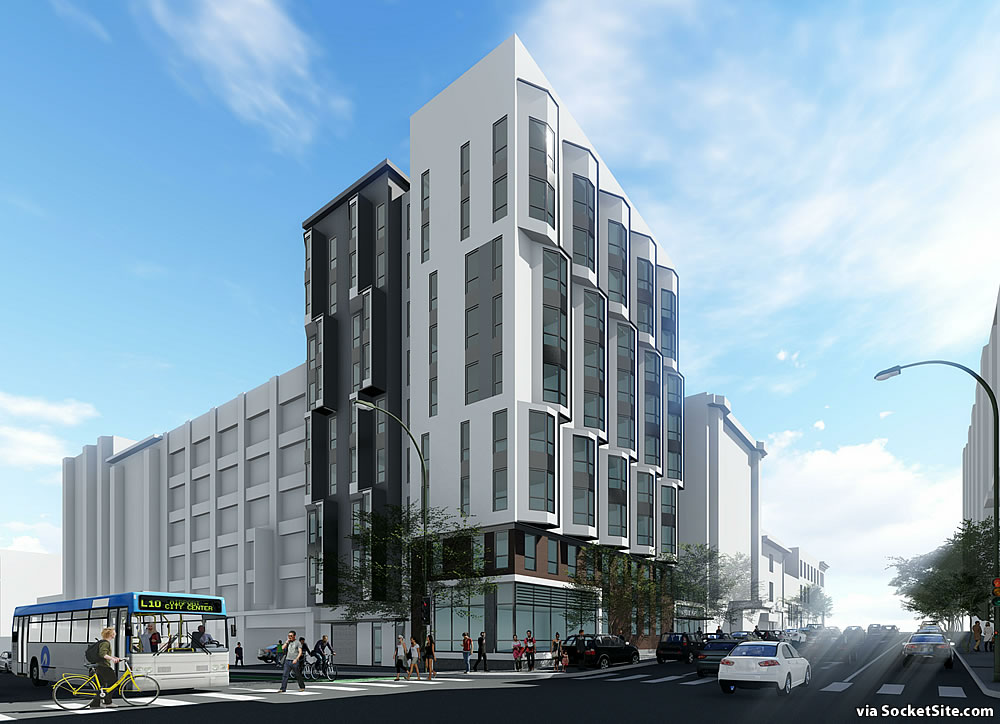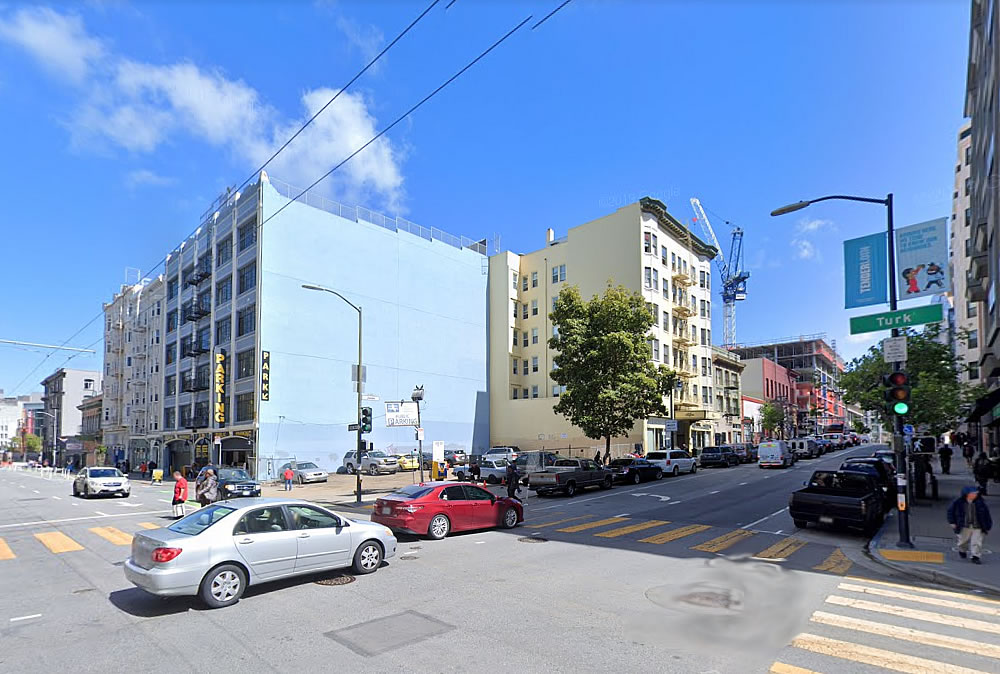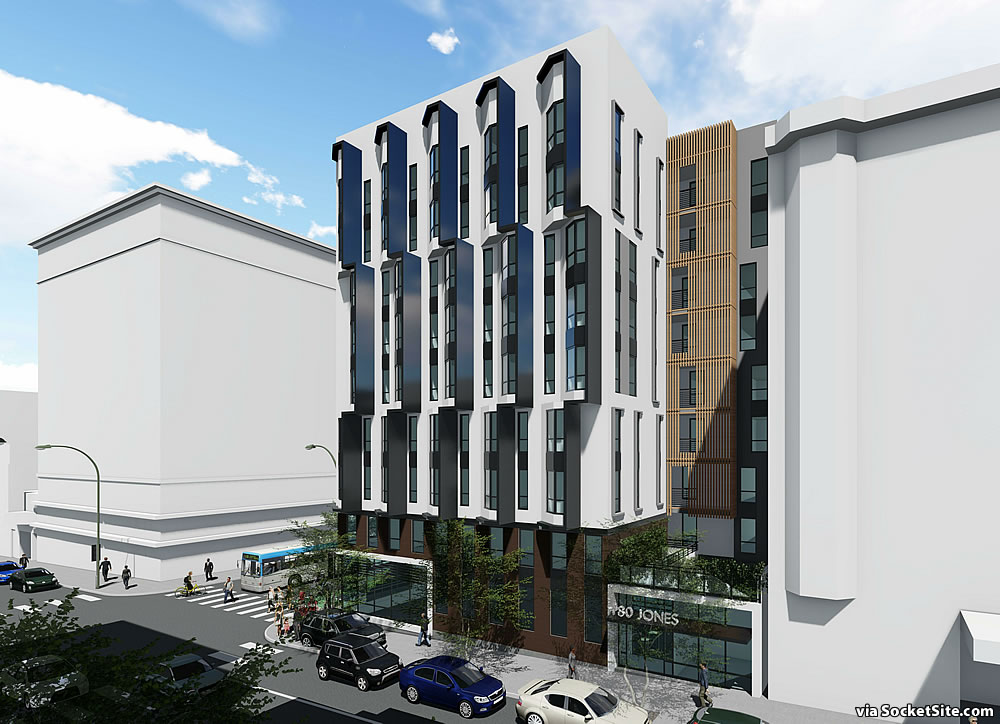Having been forced to abandoned its plans to open a temporary drug sobering center on the parking lot parcel on the southeast corner of Jones and Turk, the City is now moving forward to fund the development of a 9-story below market rate (BMR) building on the Tenderloin site, the waylaid redevelopment of which has been in the works since 2005.
As designed by Van Meter Williams Pollack for the Tenderloin Neighborhood Development Corporation (TNDC), the development as envisioned would rise up to 85 feet in height and yield 70, 340-square-foot studio apartments, a community room and space for a building manager and social workers.
And with the Mayor’s Office of Housing and Community Development about to request the release of a Home Investment Partnership Program (HOME) grant from the United States Department of Housing and Urban Development’s (HUD) in order to kickstart the development, the ground at 180 Jones is now expected to be broken in the first quarter of 2022.



Very disappointed with the new Muni color scheme.
Was this a copy and paste mockup from another city?
This design seems quite interesting and not the cookie cutter scheme we see so often…looks like some thought and actual designing went into this one. I will look forward to experiencing the finished project.
Why is it so important for San Francisco to spend so much money on below-market-rate units and why do the vast majority of them seemingly all have to be in the Tenderloin?
> Why is it so important for San Francisco to spend so much money on below-market-rate units
Because terminal NIMBY brain caused there to be a chronic under-building of housing stock for 40+ years, constraining supply far below demand levels and driving up housing costs at a rate that massively outpaced wage growth. Because of all that, today there’s a greater need for income controlled housing units than there would have been with better housing policy for the past several decades.
>why do the vast majority of them seemingly all have to be in the Tenderloin?
The vast majority aren’t built there.
BMR units are just another tool to keep poor people poor. There are many people who bought BMR units and regretted it. Since it can’t never gain value, and actually can lose value because it can be much harder to sell (the audience is so restricted). It basically fools poor people to think that it is an investment when it is not.
Your understanding of the BMR market is incorrect, at least in terms of the mechanics. And while appreciation for BMR units is restricted, and the allowable resale price for a unit, which is set by the City, is based on the increase in the Area Median Income versus property values, BMR units typically gain in value over time.
Yes BMRs for resale have historically appreciated over time. I may be mistaken but I do not believe these BMR units will be for sale, but rather affordable rental properties. Don’t get me wrong I support this project and most affordable projects. Maybe Randy can clarify if the affordable units are for sale or rent?
That’s correct, these will be rental units with an on-site property manager, social worker and supportive services.
Don’t forget that you also build equity which can then roll into another investment when you are ready to move on. So instead of paying $20,000+ to a landlord annually, you can capture a percentage of that living cost.
We should be spreading these units out across the city and not concentrating them solely in the Tenderloin (with limited access to parks, etc).
But this is looks quite nice. Bravo design team. Let’s build it!
The total development budget for this 38,410 sf project with (70) Single-Room-Occupancy (SRO) Units is $50,097,385 — according to the application submitted by the non-profit developer, Tenderloin Neighborhood Development Corporation (TNDC) to the California Tax Credit Allocation Committee (CTCAC).
These SRO Units average 315 sf each.
That works out to be an astronomical $715,677 per Unit and a whopping $1,304/sf.
Evidently affordable housing doesn’t mean cost-effective housing……not by a long shot.
There has got to be a better way.
Did you work in the common area square footage into your calculations?
Well except to follow land use battles in SF is to follow the money. Not long term sustainable quality neighborhoods. Not housing opportunity for regular working schmo’s. Not adding beauty and uplifting the city. Just money. That’s what drives the fauxgressive “us vs them” neighborhood groups, the Unions, the Mayor’s office, the YIMBY’s, the Weiners, the BOS. All of them and all of it. Money money money. Money. Lowest common denomi-dollars.
Yeah, modular construction is one way to significantly reduce costs (even if they remain conceptually too high using this method), which we’ve seen supported by a good number of recent projects in the region. But construction unions oppose them and the Board of Supervisors has expressed pretty directly that they likely won’t approve more. That of course is wildly misguided, especially when it comes to BMR housing.
On Trulia there are currently 139 condos for sale at less than $700K.
81 are less than $600K.
55 are less than $550K.
The vast majority of these condos have at least 1 bedroom; many have 2 bedrooms.
Why don’t we just give every one of these future tenants, the taxpayer-provided money that is being spent on this “non-profit” SRO rental development, so that they can buy one of these existing, much bigger/nicer condos instead?
“Affordable rental housing'” development — as defined by projects like 180 Jones — is simply a racket.
While modular units can bring the cost down, I don’t think they can use modular units in type-1 construction.
It’s important to understand that this project meets the affordable housing requirement for the nearby condos being built at 950-974 Market. The developer graciously agreed to buy a nearby site for 100% affordable units rather than meet her inclusionary requirements on site. That’s why this project had to be in the Tenderloin.
“Graciously”?
Granting “Randy Shaw” the maximum benefit of the doubt and assuming he’s not the developer or shilling for them, I’m guessing what that comment was getting at was that this project is actually going to bring units to the BMR segment of the market in the near term.
Many, many S.F. residential projects similar to the one he mentions above simply pay in lieu fees which go into a fund to pay for development in the future, and those units might be brought to the BMR market decades on when costs are higher and result in fewer units. In that respect, paying to acquire an actual buildable parcel is more “gracious” than the alternative.
But your incredulousness, might be warranted. It seems obvious to me that not meeting the inclusionary housing requirements with units on site mean that the 100% non-BMR building will be more profitable for the developer, ultimately. The developer for the condos being built at 950-974 Market has all the data available to them and made this choice intentionally, which is telling.
I guess I am a minority, but that is a fugly building to me. On the other hand, baby blue roofs on teh Muni will certainly have a traffic calming effect.
its amazing that Don Faulk (TNDC) and Randy Shaw (THC) can build whatever they want in the Tenderloin but will use strongarm tactics against any developer wishing to do so. These narcassists and their political allies need to be exposed.
“Forced to abandon plans to open a drug sobering center” – isn’t the entire neighborhood an open-air drug sobering center?